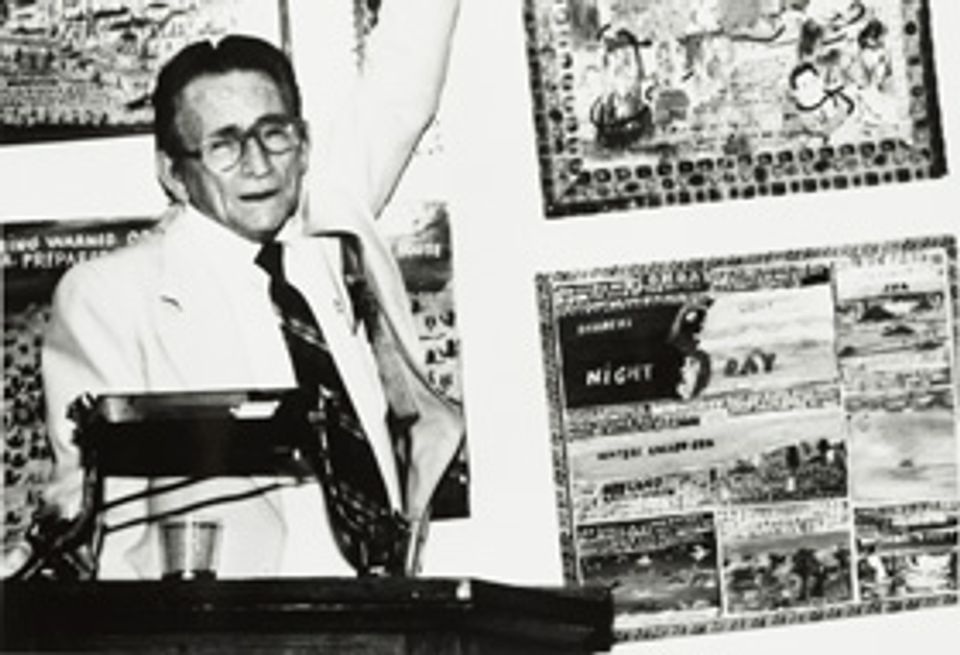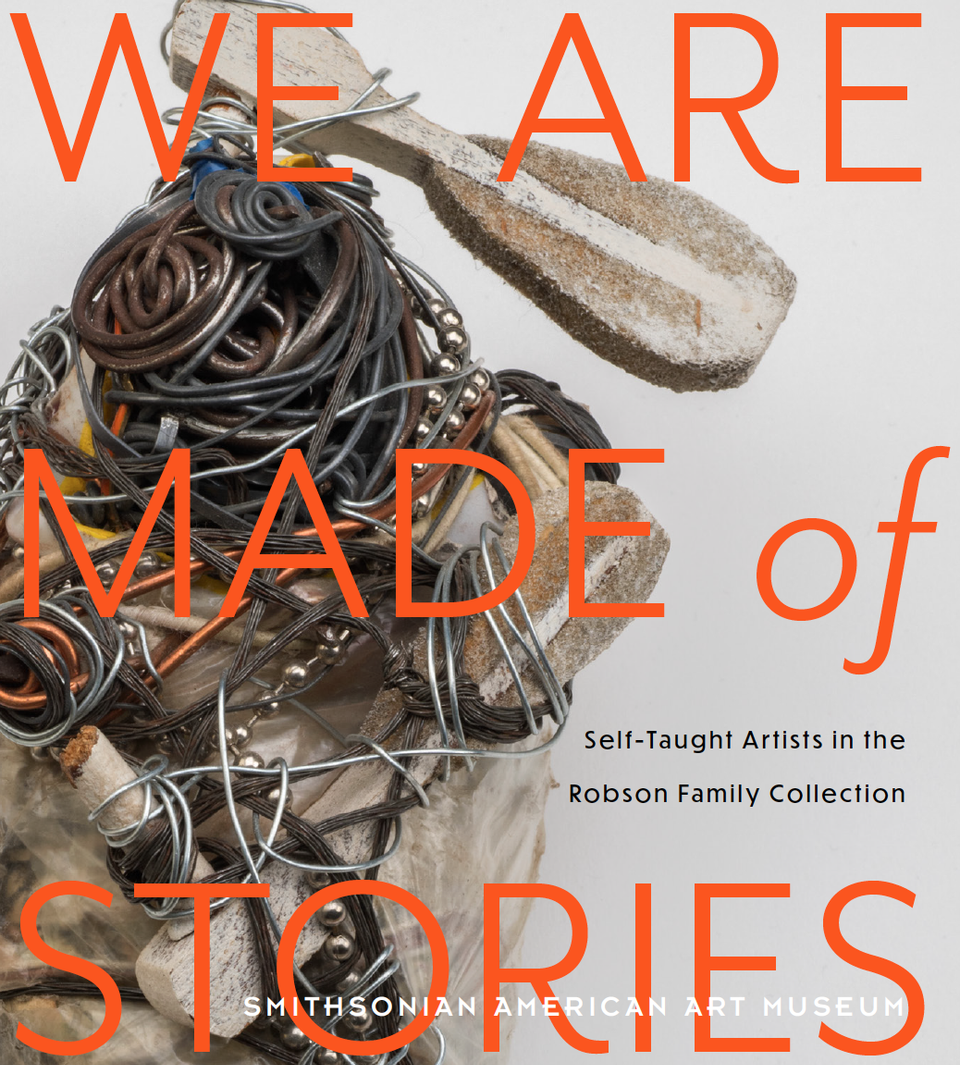Howard Finster

- Biography
The Reverend Howard Finster is perhaps the most famous religious artist alive today. Because Finster realized that his congregation did not remember his sermons even minutes after he had finished, he published religious songs and poetry in local newspapers in the 1930s and hosted a radio prayer show in the late 1930s and early 1940s. He claims God charged him to illustrate his religious visions in 1976 when "A warm feeling came over me to paint sacred art."
Finster began building his everchanging environmental sculpture, Paradise Garden, on swampy land behind his house in the early 1960s. Composed of walkways and constructions made from cast-off pieces of technology, the Garden assembles individual monuments to human inventors into an all-encompassing "Memorial to God." Much of the building material in the garden was accumulated from Finster's television and bicycle repair businesses and his twenty-one other trades.
Lynda Roscoe Hartigan Made with Passion: The Hemphill Folk Art Collection in the National Museum of American Art (Washington, D.C. and London: National Museum of American Art with the Smithsonian Institution Press, 1990)
- Artist Biography
I half expected a choir of angels on silvery wings to announce the death of the Reverend Howard Finster, but instead I learned from Roberta Smith in the New York Times that Georgia's most prominent artist had died last October 22 at the age of eighty-five. Perhaps it was no less miraculous that a Baptist preacher from the tiny town of Pennville commanded the attention of the art world. Finster loved an audience.
He was a larger-than-life personality with a devoted following long before he appeared on the Johnny Carson Show or in an R.E.M. music video. For his speaking engagements, he wore a powder-blue suit and had his banjo at the ready. He sang with a melodious twang, and he could yodel with force, but it was his compelling "sermons in paint" that made him a folk art phenomenon.
Born in Valley Head, Alabama, Finster was one of thirteen children. At sixteen he preached his first sermon. In the 1940s, he hosted a radio program and wrote a column for the local newspaper. He led tent revivals and "pastored" many churches. To support his wife, Pauline, and their five children, he was also a bricklayer, a carpenter, a plumber, and took up the "hard times business" of bicycle and lawn mower repair. He had a great sense of humor, which he used in the service of the Word. He once told me, "When I'm in big revivals, about the first thing I do a lot of times is to get the people tickled a little bit, get their mind off everything, then I get the message over to 'em."
Finster never tired of telling the story of how he came to be an artist. In 1976, he dipped his finger in white paint and saw a perfect human face on the ball of his finger, and "while I was lookin' at it a warm flash kind'a went all over me, all the way down, and it said, 'Paint sacred art.' And I said to it, I said, 'I cain't do that. I know professionals can, but not me.' And it comes to me again and it says, 'How do you know?' I said, 'How do I know that I cain't paint.' I tuck a dollar out of my wallet, and I pasted it on a piece of plyboard and went out in front of my shop, and I started drawing George Washington off that dollar bill." Whether true or not, the story stands as a parable of his faith in divine visions, as well as in his ability to make money.
In the 1960s, he began constructing Paradise Garden, a two-acre spiritual environment at his home in Pennville. His plan was to display all the inventions of mankind. Embedded in the garden's cement walls, walkways, and playhouses were Bible verses, accumulated bicycle parts, TV tubes, mirror glass, Coca-Cola bottles, junk jewelry, plastic toys, a mound of cement snakes, and his son's tonsils "put up in alcohol." Finster displayed his paintings and plywood cutouts ("dimensions") of Santa Claus, Abraham Lincoln, famous inventors, and Bible figures in the garden, and it wasn't long before collectors and the curious beat a path to his door to buy his art. "They'd come here and just blow up on it, so I'd just take the crowbar and start pulling it off," he told me. He made thousands of works of art that often combine written words with his own vocabulary of visual images.
At home Finster would kick back on his studio couch witha chaw of tobacco in his cheek and carry on a stream-of-consciousness monologue for hours. Like a perpetual-motion machine, he seemed to gain energy from his own oration. He had lots of ideas, mostly about how to fix things, from TVs to the Middle East crisis. His handyman's sensibility made anything seem possible. For all of his fire-and-brimstone swagger, there was a sweetness about him. He encouraged people to discover their hidden talents; if they didn't, "it was just like takin' a quart of milk and stickin' it in the refrigerator and lettin' it sit there till it spoils." He also talked about his visions—all the strange and beautiful sights on his travels through the twilight zone. He told me that he had walked through hell and had witnessed eternal suffering, that Elvis Presley had appeared to him, and that he'd seen other fantastic scenes as well. The next minute he'd be down to earth. He didn't like buying anything on credit because he couldn't see much difference in paying for something and then waiting a week to pay interest on it. There was a fine line between his religious convictions and pure business savy; he didn't sign contracts, he told me, because God is a free agent.
One could say that all artists are visionaries, but Finster was tuned to a special frequency. He took on the the big topics—life and death, redemption and salvation. In the 1970s and 1980s, that angst-ridden era of few certainties, here was a man of solid convictions, pointing the way. It's no wonder he was a hero to hipsters.
I first met Finster in the summer of 1984, when I interviewed him for the Archives of American Art's oral history program. He was in Washington, D.C., for an exhibition at the Anton Gallery, then on Capitol Hill. The interview almost didn't happen because he wanted to be paid. A novel idea. We negotiated. He agreed to talk and sing and preach for free, for hours. (His words quoted here are all from that 1984 tape recording.) After the interview we had lunch at the cafeteria in the Old Patent Office Building, where the archives were then located. He was so tickled with the choices that he took one of everything. We spent the afternoon in the courtyard under the elm trees feeding his leftover sandwiches to a growing flock of pidgeons.
In 1988 I took a film crew to Finster's compound to shoot a segment for the TV program Smithsonian World, and we continued to correspond quite a bit in the 1990s. He had a special regard for the Smithsonian Institution, which mirrored his mission to collect the wonders of the world. And he was grateful to the Archives of American Art for microfilming his papers and making them freely available. The film crew and I arrived with the worst snowstorm to hit Georgia in forty years. What bad luck, I thought, as I scraped the frost form the windows, a virutal prisoner of the only motel in town. We had two days to film Paradise Garden, which was buried under a pile of snow. I had little faith, but Finster saved us. With the cameras rolling, it was more remarkable to to hear him talk about what was under the snow than to actually see it. It was a striking demonstration of his power to behold the hidden, to show us a world that only he could see. He had spent a lifetime animating the intangible—from the fiery pits of hell to heavenly mansions "beyond the light of the sun."
He thought that good Christians were scarce. In his own words he was "one of the world's last red lights." "I'm not here to live a normal life," he told me. "I'm sent here on a mission. I was fore-predestinated for this planet. Just like Henry Ford." I admired his compulsion. He worked night and day with all of his energies bent toward the single-minded purpose of spreading the Word. Recalling his remarkable journey, he said, "It's all been fun, it's all been spiritual, it's all been rejoicing, it's all been a sacrifice. It's been a hard road. It's been an easy road. It's just been everything." With Finster's passing, I will look more closely at his paintings, searching the surfaces for a smear of paint with the perfect face of Howard Finster looking back at me.
Liza Kirwin "Appreciation: The Reverned Howard Finster, the Last Red Light before the Apocalypse." American Art journal 16, no. 2
Luce Artist BiographyReverend Howard Finster preached his first sermon when he was just sixteen years old. He traveled around conducting baptisms, weddings, and funerals, and published some of his sermons in local papers in an attempt to reach more people (The New York Times, "Howard Finster," 2001). In the 1960s, Finster started building Paradise Garden, an environmental sculpture made from machine parts, Bible verses, Coca-Cola bottles, and even his son's tonsils. He made his first painting in 1976 after he dipped his finger in white paint and saw a perfect human face on the tip of his finger. When the face told him to "paint sacred art," Finster argued that he didn't know how. He eventually agreed to give it a go and used tractor enamel and plywood to create images of famous people and visions of heaven and hell (Liza Kirwin, "The Reverend Howard Finster," American Art, Summer 2002). He slept in his clothes and only took twenty-minute naps in an attempt to get out all his ideas. By 1995, a newspaper article reported that he was working on his "36,892nd" painting (The New York Times, Howard Finster, 2001).















